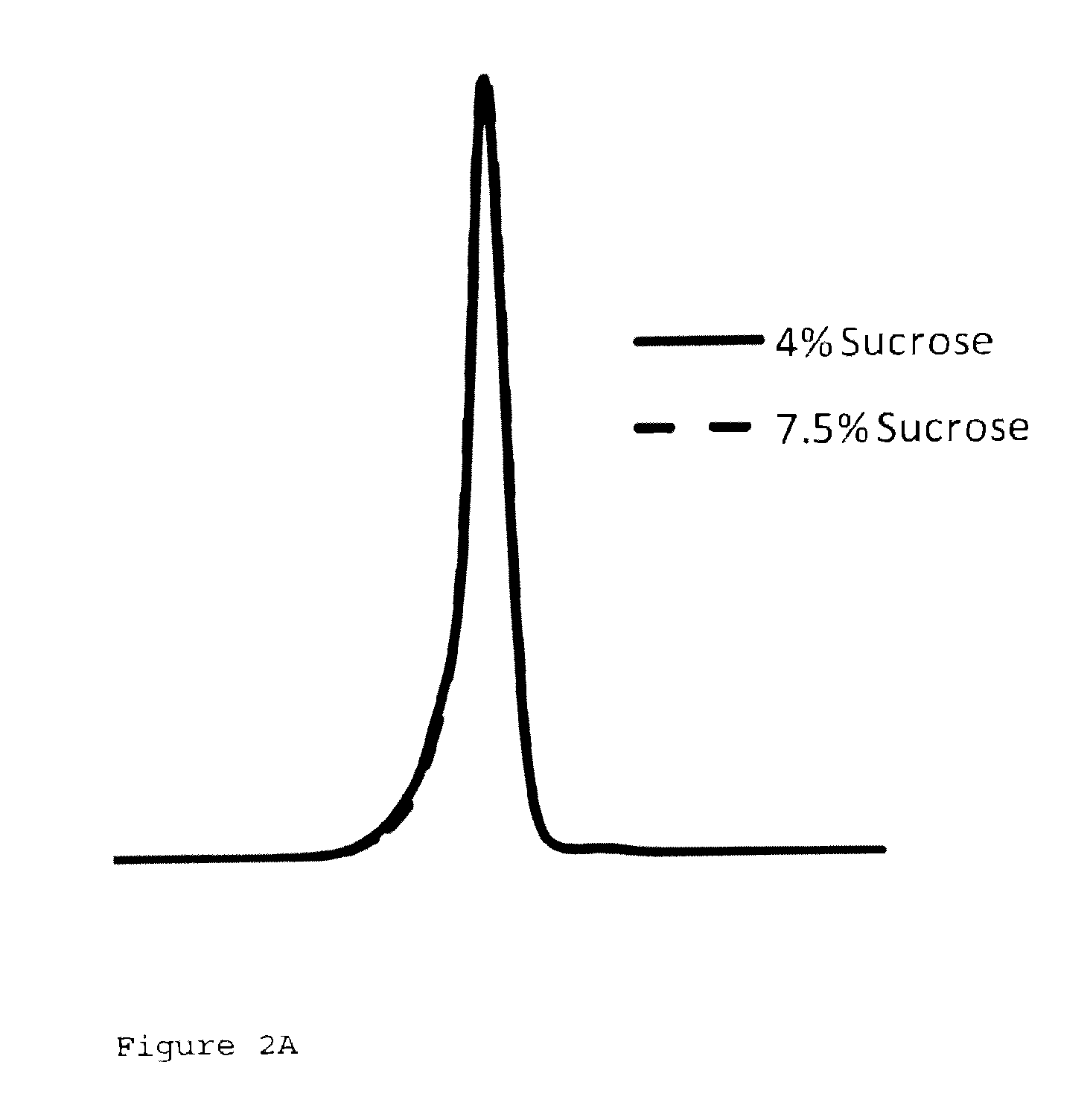Reconstituted HDL formulation
a high-density lipoprotein and formulation technology, applied in the direction of drug compositions, peptide/protein ingredients, metabolic disorders, etc., can solve the problems of exacerbate renal problems, process generates a variety of freezing and drying stresses, etc., to reduce the risk of renal toxicity, and good stability
- Summary
- Abstract
- Description
- Claims
- Application Information
AI Technical Summary
Benefits of technology
Problems solved by technology
Method used
Image
Examples
example 1
Preparation of the Samples
[0065]To make the samples for the following experiments, sodium cholate (New Zealand Pharmaceuticals) was dissolved in buffer (10 mM NaCl, 1 mM EDTA, 10 mM TRIS, pH 8.0) and stirred until clear. Soybean phosphatidylcholine (Phospholipid GmbH) was added to an appropriate volume of the cholate and stirred for 16 h at room temperature. The Apo A-I solution was diluted to a protein concentration of 9.0 mg / mL (determined by OD280) with 10 mM NaCl and mixed with an appropriate volume of the lipid solution to obtain protein to lipid ratio in the range of 1:45 to 1:65. The mixture was stirred at 2-8° C. for 30 min to 16 h. The HDL mimetics were prepared by cholate dialysis using 1% sucrose as a diafiltration buffer. The eluate was concentrated to a protein concentration of 33 to 38 g protein / L. Sucrose was added to obtain the desired concentration (1%, 2%, 3%, 4%, 5%, 6.5%, 7%, 10% w / w). The pH of the solution was adjusted, with 0.2 M NaOH to pH 7.50±0.1 after whic...
example 2
Molecular Size Distribution
[0067]Particle formation was determined using HPLC-SEC and assessed by the molecular size distribution of the various formulations. Little difference was observed for formulations containing 5-10% w / w sucrose in the final formulation (FIG. 1), indicating that formulations containing ≧5% w / w sucrose did not affect particle stability after reconstitution. FIG. 1 shows a complete chromatogram of (1) internal control, 2: 5% w / w sucrose, 3: 6.5% w / w sucrose, 4: 7.5% w / w sucrose and 5: 10% w / w sucrose.
[0068]In addition a direct comparison between a 7.5% w / w sucrose formulation and 4% w / w sucrose formulation demonstrated that these formulations exhibit a similar molecular size distribution (FIG. 2A).
[0069]FIGS. 2B and 2C show the results for sucrose concentrations 1, 2, 3, and 4% (w / w) and formulations comprising sucrose and proline.
[0070]All tested formulations are stable. The sucrose content of 4 to 7.5% w / w was optimum and did not affect the particle stability...
example 3
LCAT Activation
[0071]A measure of the effectiveness of the rHDL particles in various formulations was determined by measuring the LCAT activity. HDL particles are capable of sequestering cholesterol from plaques formed along artery walls or cells by interaction with the ATP-binding cassette transporter A1 (ABCA1). Lecithin-cholesterol acyltransferase (LCAT), a plasma enzyme converts the free cholesterol into cholesteryl ester (a more hydrophobic form of cholesterol), which is then sequestered into the core of the HDL particle before being transported to the liver to be metabolized. If the sucrose content in the final formulation affected the efficacy of the rHDL particle, LCAT activity would decrease.
[0072]FIGS. 3A and 3B show LCAT activity for 4-10% w / w sucrose formulations. FIG. 3C shows LCAT activity for 1-4% w / w sucrose formulations. Very little difference is seen in LCAT activity when the sucrose ranges from 5-10% w / w in the final formulation (FIG. 3A), however a slight decreas...
PUM
| Property | Measurement | Unit |
|---|---|---|
| concentration | aaaaa | aaaaa |
| concentration | aaaaa | aaaaa |
| size | aaaaa | aaaaa |
Abstract
Description
Claims
Application Information
 Login to View More
Login to View More - R&D
- Intellectual Property
- Life Sciences
- Materials
- Tech Scout
- Unparalleled Data Quality
- Higher Quality Content
- 60% Fewer Hallucinations
Browse by: Latest US Patents, China's latest patents, Technical Efficacy Thesaurus, Application Domain, Technology Topic, Popular Technical Reports.
© 2025 PatSnap. All rights reserved.Legal|Privacy policy|Modern Slavery Act Transparency Statement|Sitemap|About US| Contact US: help@patsnap.com



